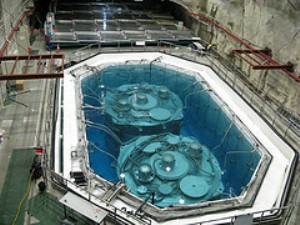Two antineutrino detectors have been installed as part of the Daya Bay Reactor Neutrino Experiment for observing the exchanges of antineutrinos, which are produced by the reactors at the China Guangdong Nuclear Power Group Power Plant situated near Hong Kong.
The antineutrinos and the neutrinos have long been a source of mystery to the world, especially with regard to the reason for the predominance of matter over antimatter in the universe.
 Twin detectors are installed in the Daya Bay Reactor Neutrino Experiment to record interactions of elementary particles called antineutrinos produced by powerful reactors at the China Guangdong Nuclear Power Group power plant in southern China. The antineutrino detectors are ready for data taking. Credit: Karsten Heeger, University of Wisconsin
Twin detectors are installed in the Daya Bay Reactor Neutrino Experiment to record interactions of elementary particles called antineutrinos produced by powerful reactors at the China Guangdong Nuclear Power Group power plant in southern China. The antineutrino detectors are ready for data taking. Credit: Karsten Heeger, University of Wisconsin
Karsten Heeger, who is one of the leading researchers in the experiment, and also a Physics Professor at the University of Wisconsin-Madison, has revealed that it was well-known that during the Big Bang both matter and antimatter were created in equal amounts, but at present only matter reigns. The reason for this imbalance is not known and the experiment uses antineutrinos as a probe to find out the reason by taking measurements of an important transformation known as neutrino mixing. Electron, tau and muon are the three types of neutrinos which could transform from one form to the other while they move through matter and space.
Yifang Wang, from the Daya Bay Experiment has stated that this amazing experiment had been carried out with the help of hundreds of engineers and physicists. The antineutrinos and neutrinos do not carry any charge and are very small, hence could easily penetrate into massive amounts of matter, such as the Earth without interacting in any way.
Heeger has been working for the past eight years on this experiment and has contributed to the development and design of the eight antineutrino detectors, which would be placed in eight different locations. Heeger along with other team members from the UW Madison PSL have built the target vessels for the detector made from acrylic along with other key components.